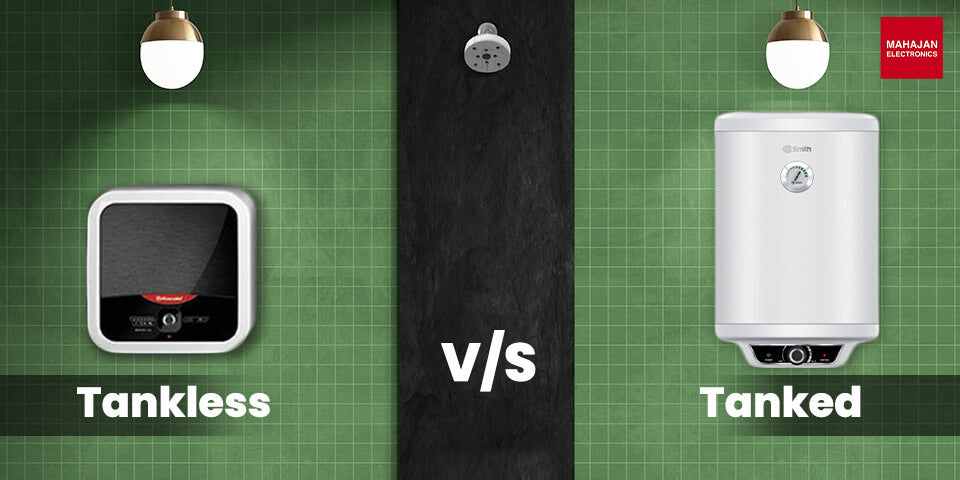The cold winds are knocking on the door, and winter is approaching, making it the right time to add geysers to your household collection. However, selecting the best option that caters to your home requirements isn’t as simple as it may seem, thanks to the countless options available.
So, what option should you go for - Tankless or Tanked? If you are struggling to make a choice, it’s better to scroll through the page and find the key differences here. Browse the guide carefully and make a wise choice.
What are Tanked and Tankless Geysers?
Before we slip into the differences, let’s outline the basic information about Tanked and Tankless Geysers to have a clear idea. Keep reading to the end and gather all the required details about two leading geyser types.
Tanked Geysers
Let’s start with the most used one - Tanked Geyser. It is used in all traditional homes and is available in two variants - gas and electric. Tanked geysers are insulated to keep the inner water warm. It features a thermostat to control temperature.
What makes Tanked Geysers worth using is its low maintenance and inexpensive cost. These only require draining and flushing twice a year to last for a long. Below are mentioned the pros and cons of tanked geysers.
|
Pros |
Cons |
|
Low maintenance |
Tank may take up a lot of space |
|
Fewer installation |
Limited capacity |
|
Low replacement cost |
More energy is required to maintain the temperature of stored water |
|
Easily adapted to re-circulation and pre-heat applications |
Shorter lifespan |
Tankless Geysers
Tankless Geysers are a new innovation attracting all eyes and ears these days. As the name suggests, these geysers utilize powerful burners to heat the water quickly. Contrary to the tanked option that heats limited quantity, this geyser can heat water as it passes through the heating element. It doesn’t need any container or tank to store that water. Like tanked geysers, it also requires either electricity or gas to operate.
Let’s outline the key pros and cons of tankless geysers here.
|
Pros |
Cons |
|
It usually lasts between 20 to 30 years |
Expensive |
|
These are small and can be installed in tight spaces. |
Limited output, as it doesn’t store a huge amount of water. |
|
It can deliver 2 to 3 gallons of hot water per minute. |
The replacement can be pricey. |
|
Tankless heaters reduce energy costs by 25%. |
It requires regular professional maintenance. |
Tanked Vs. Tankless Geysers - The Key Differences to Know
Now that you know about the basics of Tanked Vs. Tankless geysers, let’s move on to the key differences between these two geyser types.
The first thing we should check before purchasing a geyser is its durability - after all, we don’t want to spend on this appliance every year. And the tankless geyser clearly wins the race. It lasts 20 to 30 years, almost double the life of a storage tank water heater. These water heaters have a shorter lifespan, and they can last only about 10 to 15 years.
Here comes the real question - which of them is energy-efficient? And the answer is pretty simple - tankless geysers. To your surprise, tankless geysers can reduce energy costs by 25% as the energy is not used until hot water is needed.
On the other hand, tanked geysers use more energy to maintain the temperature of the stored water. This leads to higher utility bills. So, if you want to keep your energy bills down, consider installing tankless geysers in your home.
The price is another important factor we cannot overlook when differentiating between tankless and tanked geysers. And tanked geysers have a slight edge here. Tanked geysers are available at an affordable price and have lower maintenance and repair costs. It only requires draining and flushing twice a year, thus making the appliance cost-efficient.
Tankless geysers, on the contrary, come with a pricey tag. These have a higher purchase cost than a traditional storage tank geyser and require regular professional maintenance, further adding to the expense. Besides, the replacement of tankless geysers can be pricey, thus making them unsuitable for budget-savvy customers.
Last but not least, the factor that differentiates both geyser types is their input and output capacity. Tanked geysers have a limited capacity, and they can heat water to the tank size limit. However, tankless geysers can heat water as it passes, making them ideal for regular household chores without waiting for another slot.
Summing Up
All in all, we can safely say that both tanked and tankless geysers have ups and downsides. While tankless geysers heat water as it passes through and require small space to install, tanked geysers are cost-efficient and require less maintenance. So, the final choice comes down to your preferences and budget. Hence, it’s recommended to outline your needs and purchase accordingly.

